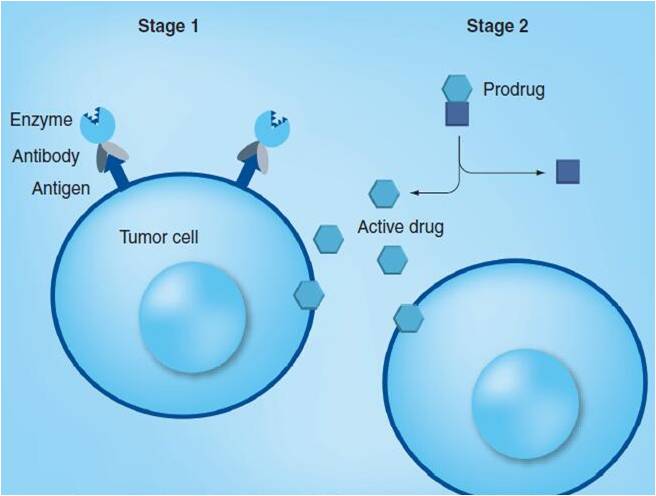- Home
- UTC Development
- Antibody-Enzyme Conjugate Development
- Linker Synthesis for ADEPT
Linker Synthesis Service for ADEPT
Creative Biolabs is a professional expert in providing comprehensive customized antibody-directed enzyme prodrug therapy (ADEPT) development services with the most suitable linkers for targeted immunotherapy. Based on advanced DrugLnk™ platform, we promise to design and generate the most appropriate linkers for your ADEPT project development.
ADEPT
ADEPT is one of the forms of antibody-drug conjugate (ADC). The linker technology profoundly affects the toxicity, stability and half-life, and ultimately the efficacy of the ADC. In ADEPT, the conjugation of antibody or antibody fragment is usually carried out by conventional linkers, including 2-mercapto-[S-acetyl]acetic acid, N-hydroxysuccinimide ester (SATA), and m-maleimidobenzoyl-N-hydroxysuccinimide ester (SMPB). However, previous research showed that some enzymes, such as CPG2, are relatively sensitive to modification. What’s more, insertion of three maleimide groups per CPG2 may result in the loss of enzyme activity to some degree. Therefore, to avoid the activity lost of enzyme, Creative Biolabs offers customized linkers for specific enzymes to achieve coupling without affecting enzyme activity.
 Fig.1 Schematic structure of antibody links to payload (enzyme) via the linker.
Fig.1 Schematic structure of antibody links to payload (enzyme) via the linker.
Linkers Used for ADEPT
ADEPT is progressively developed into an attractive therapy method for cancer treatment. The antibody component confers the agent with exquisite specificity for targeting both primary tumors and metastases. The enzyme component can be cytotoxic or, when localized, to activate a prodrug. What’s more, the linker part could facilitate the conjugation of enzyme to antibodies and in the meantime, dictate the release mechanism of an ADEPT.
- In ADEPT, the SATA (N-succinimidyl S-acetylthioacetate) is a typical cross-linker, thereby adding sulfhydryl groups to proteins and other amine-containing molecules in a protected form. The modified molecule can be stored and treated with hydroxylamine to expose the labile sulfhydryl group when needed for conjugation reactions. SATA has an N-hydroxysuccinimide (NHS) ester, which forms a stable, covalent amide bond with primary amines and releases NHS as a by-product. De-protection (deacylation) to generate a free sulfhydryl is achieved using hydroxylamine-HCl.
- SMPB and its water-soluble analog Sulfo-SMPB are heterobifunctional cross-linkers that contain N-hydroxysuccinimide (NHS) ester and maleimide groups that allow covalent conjugation of amine- and sulfhydryl-containing molecules. NHS esters interact with primary amines at pH 7-9 to form amide bonds, while maleimides react with sulfhydryl groups at pH 6.5-7.5 to form stable thioether bonds. The stability of the maleimide group is better than the NHS-ester group but will slowly hydrolyze and also lose its reaction specificity for sulfhydryls at pH values > 7.5. Therefore, these crosslinkers usually are used at pH 7.2-7.5, with the NHS-ester (amine-targeted) reaction being accomplished before or simultaneous with the maleimide (sulfhydryl-targeted) reaction.
 Fig.2 Antibody-directed enzyme prodrug therapy. A staged system of cancer therapy. (Andrady, 2011)
Fig.2 Antibody-directed enzyme prodrug therapy. A staged system of cancer therapy. (Andrady, 2011)
Creative Biolabs is dedicated to helping you develop novel ADEPT with optimized linkers for different enzymes in a timely and cost-effective manner. Our high-quality services and products will contribute greatly to the success of your projects. We also provide other various services regarding ADEPT development. Please feel free to contact us for more information.
Reference
- Andrady, C.; et al. Antibody-enzyme fusion proteins for cancer therapy. Immunotherapy. 2011, 3(2), 193-211.
For Research Use Only. NOT FOR CLINICAL USE.

Online Inquiry
Welcome! For price inquiries, please feel free to contact us through the form on the left side. We will get back to you as soon as possible.
